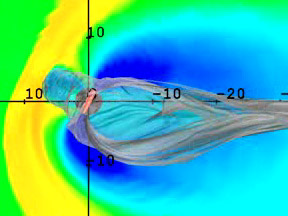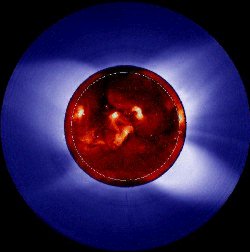Image of the solar corona in white light (outer circle, blue and white) and X-Rays (inner circle, red, yellow, and black) on April 22, 1994, courtesy of the High Altitude Observatory and the Yohkoh Science team. The dashed circle is the solar radius.
Click on image for full size
Image courtesy of the High Altitude Observatory, National Center for Atmospheric Research (NCAR), Boulder, Colorado, USA. NCAR is sponsored by the National Science Foundation.The solar X-ray image is from the Yohkoh mission of ISAS, Japan.
The Solar Atmosphere
The visible solar atmosphere consists of three regions: the
photosphere,
the chromosphere, and the solar corona. Most of the visible (white) light
comes from the photosphere,
this is the part of the Sun we actually see.
The chromosphere and
corona also emit white light, and can
be seen when the light from the photosphere is blocked out, as occurs in
a solar eclipse.
The sun emits electromagnetic radiation at many other wavelengths as well.
Different types of radiation (such as radio, ultraviolet, X-rays, and gamma
rays) originate from different parts of the sun. Scientists use
special instruments
to detect this radiation and study different parts of the solar atmosphere.
The solar atmosphere is so hot that the gas is primarily in a plasma state:
electrons are no longer bound to atomic nuclei, and the gas is made up
of charged particles (mostly protons and electrons). In this charged
state, the solar atmosphere is greatly influenced by the
strong solar magnetic fields that thread through it.
These magnetic fields, and the outer solar atmosphere (the corona) extend out into
interplanetary space as part of the solar wind.
You might also be interested in:

Most of the energy we receive from the Sun is the visible (white) light emitted from the photosphere. The photosphere is one of the coolest regions of the Sun (6000 K), so only a small fraction (0.1%)
...more
Rising above the Sun's chromosphere , the temperature jumps sharply from a few tens of thousands of kelvins to as much as a few million kelvins in the Sun's outer atmosphere, the solar corona. Understanding
...more
An eclipse of the Sun occurs when the Earth passes through the Moon's shadow. A total eclipse of the Sun takes place only during a new moon, when the Moon is directly between the Sun and the Earth. When
...more
There is a giant magnetic "bubble" in space around the Sun. That "bubble" is called the heliosphere. In a sense, we Earthlings live within the outer atmosphere of our Sun. The solar
...more
Space weather is a very complex scientific field. Scientists who study space weather use computer models a lot. Space weather is a bit like weather on Earth in this way because weather forecasters on our
...more
Large impressive loop-like structures on the edge of the solar disk sometimes stand out brightly against the dark background of space. Though these structures, called "prominences", appear to be very bright
...more
The Sun has a very large and very complex magnetic field. The magnetic field at an average place on the Sun is around 1 Gauss, about twice as strong as the average field on the surface of Earth (around
...more















